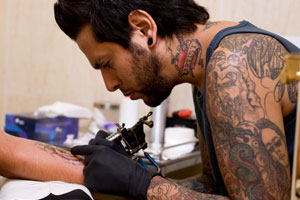AS the popularity of tattoos continues to grow, so too does the body of research on the removal techniques for those who regret their decision.
The latest available figures for Australia estimated that more than a quarter of young Australians have a tattoo. (1)
In the US, 22% of students sport a tattoo, while around 28% regret their decision within a year, and 50% of those with tattoos choose to undergo removal procedures as adults. (2)
Queensland dermatologist Dr Davin Lim predicts that future demand for tattoo removal services could be even higher.
“We are seeing a huge increase in popularity of tattoos among young people. We think they may soon be as common as the iPhone”, he says.
Former honorary secretary of the Australasian College of Dermatologists, Dr Cathy Reid, said that as the popularity of tattoos rose, so too did an emerging problem around laser removal.
Dr Reid said anyone can own and operate a laser and the college was currently lobbying for legislation and regulation on laser operations.
“What we are most concerned about is use of lasers by non-medically trained personnel”, she says.
Two new studies published in the Archives of Dermatology have examined laser removal of tattoos.
One study examined a number of factors in more than 350 patients who underwent tattoo removal and found that the success of removal by Q-switched laser was associated with a number of important variables including smoking status. (3)
The authors found that the chance of achieving removal, defined as minimal discolouration or scarring remaining after 10 treatment sessions, decreased by 69.7% in smokers compared with non-smokers, though they said this finding would need to be confirmed in further studies.
Other factors that reduced the response to removal included a shorter interval between treatment sessions, appearance of a darkening phenomenon during treatment, and various characteristics of the tattoo including the presence of colours other than red and black, larger size, location on the feet or legs, higher colour density, and older tattoos, they found.
“The effects are substantial for some of these variables. Our data could represent the basis for developing predictive models of tattoo removal that are applicable in clinical practice”, they wrote.
Sydney dermatologist and laser specialist Dr Terence Poon said that anecdotally, he had also seen better results in patients who left more time between sessions.
“Patients must balance this against how fast they want to take it off”, he said.
A second study looked at the use of a new laser, not yet commercially available. The picosecond 755-nm alexandrite laser was tested on 12 patients and the researchers deemed it a “safe and very effective” device for tattoo removal, which seemed to clear pigment in tattoos more rapidly than Q-switched lasers. (4)
They found that an average of 4.25 treatment sessions obtained greater than 75% clearance, compared to studies on Q-switched lasers that found more than eight treatments were needed for 95% clearance.
Melbourne dermatologist and laser specialist Dr Philip Bekhor said it was still early days for this technology.
“The jury is out [on the picosecond laser] but performance on green, one of the hardest colours to remove, looked fairly impressive — but it’s also going to be one of the most expensive lasers ever produced”, he said.
– Amanda Bryan
1. Commun Dis Intell 2001; 25: 67-72
2. J Adolesc Health 2008; 42: 201-203
3. Arch Dermatol 2012; Online 17 September
4. Arch Dermatol 2012; Online 17 September
Posted 24 September 2012

 more_vert
more_vert